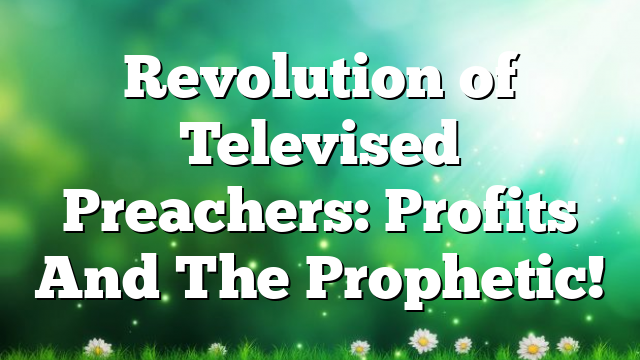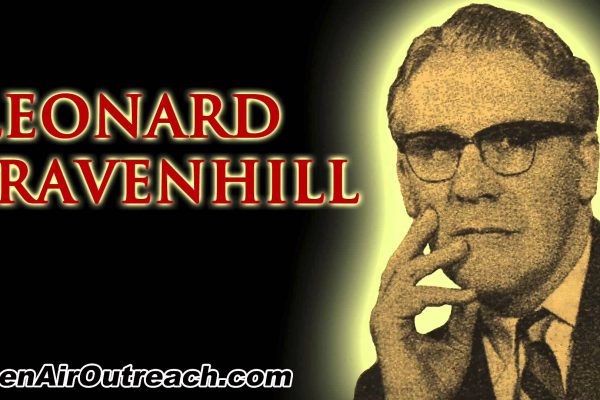Click to join the conversation with over 500,000 Pentecostal believers and scholars
Click to get our FREE MOBILE APP and stay connected
| PentecostalTheology.com



Pneuma 33 (2011) 175-179
Introduction
Will the Revolution Be Televised? Preachers, Profits and
the “Post-Racial” Prophetic!
Jonathan L. Walton*
Assistant professor, Harvard Divinity School, 45 Francis Avenue,
Cambridge, Massachusetts
jonathan_walton@harvard.edu
Te critical interface between Afro-Protestantism and mass media is one of the more defining and enduring elements of black religion in America. Beginning in the 1920s, black Protestants have employed media airwaves as tools of reli- gious proselytization and financial profit. From religious “race” records and radio broadcasts of the interwar and postwar eras to televangelism and other forms of mass-produced religiosity among post-civil rights generations, it is hard to deny media’s central role. Media have helped to shape, structure, and cement the centrality of black orality and visual presentation within Afro-Protestant practices.
Indeed, attention has been given to the performative dimensions of the chanted sermon, the emergence of gospel music, and the affective, emotive, and experiential dimensions of traditional, African-inspired worship. But the ways in which media technologies amplify, extend, impact, and even alter religious production and theological meaning among Afro-Protestants has been given relatively scant attention. Given the unprecedented power of mass media to legitimate extant authority, inform a religious structure of feeling, and serve as a site of social and theological contestation, this topic demands our attention. Te purpose of this special issue, then, is to illumine the
* I would like to offer my appreciation to the Center for the Study of Religion and American Culture, IUPUI and the Young Scholars in American Religion program. Te 2009-2011 cohort, of which I was fortunate to be a member, provided valuable encouragement, critical feedback, and a productive vision for this project.
© Koninklijke Brill NV, Leiden, 2011 DOI: 10.1163/027209611X574998
1
176
J. L. Walton / Pneuma 33 (2011) 175-179
dialogical relationship between black religion and media insofar as the latter is more than a mere technology, but rather a constitutive influence.
To be clear, the intent here is to do more than rehash Marshal McLuhan’s classic though now somewhat clichéd phrase “the medium is the message.” Borrowing from the insights of Walter Ong, this issue seeks to illustrate how technologies inform and even restructure both language and acts of interpreta- tion. Verbal vocabularies are enlarged and constricted, visual symbols are accentuated or obscured, and media forms often determine timing and tempo on the one hand and even cultural acceptance on the other. According to Ong, “Technologies are not mere exterior aids but also interior transformations of consciousness, and never more than when they affect the word.”1 Where reli- gion is involved, such dynamics influence the ways persons think about, invest meaning in, and ultimately give articulation to ideas of the sacred. And when discussing a religious tradition as aesthetically dependent on the ritual of rhe- torical performance as African American Protestantism, it only makes sense that scholars might address this symbiotic relationship between secondary orality and the sacred. Te authors contributing to this volume fear, again somewhat to paraphrase Ong, that Pentecostal faith communities have so interiorized the technologies of mass media that participants can hardly recog- nize their presence or influence.2
To demystify the otherwise perceived natural attributes of religion and mass media is not the same as to condemn them. Tis volume should not be read as a collection of doom and gloom prophecies lamenting how mass media distort “true religion.” Tough technologies are artificial, tools have the capacity to diminish, distort, enhance, and improve. Media should not be read here as simply foils to “good religion,” a term religious historian Robert Orsi inter- prets as quintessentially a “disciplinary word, built out of and for exclusion.”3
1
Here Walter Ong is speaking specifically of “literate” cultures and the technology of chirog- raphy (and typography). But, of course, writing cultures serve as the baseline for what Ong has identified as secondary orality, the electronic uses of radio and television. So whether writing or advanced media technologies, they impact and ultimately transform language and interpreta- tion. Walter Ong, “Writing Is a Technology Tat Restructures Tought,” in Te Written Word: Literacy in Transition, Wolfson College Lectures 1985, ed. Gerd Bauman (New York: Oxford University Press, 1986), 32.
2
Ibid., 24.
3
Orsi’s overall argument explores how the academic study of religion privileges faith perspec- tives considered rational, emotionally restrained, nonhierarchical, non-ritualistic, decidedly monotheistic and democratic. Such perspective creates a normative, though often unnamed, backdrop of “good religion” versus “bad religion” insofar as the vast majority of religious beliefs/ practices (particularly among self-professed Pentecostals) are deemed religiously out of bounds at
2
J. L. Walton / Pneuma 33 (2011) 175-179
177
Rather, this volume seeks to show how media contribute to the complex dynamism of religious faiths in general and Pentecostalism in particular. Te essays that comprise this issue represent an array of disciplines and theo- retical approaches. Te fields of church history, Christian social ethics, cultural theory, and homiletics are represented. Our goal is to analyze the interplay between media and Afro-Protestantism in light of historical developments and cultural trends, while evaluating ethically the ecclesiastical strategies, ritu- alized patterns of behavior, and conceptions of the sacred. Tus the essays presented in this volume are of two sorts: the historical/descriptive on the one hand, and reflective/constructive on the other.
Te first two essays attend to, in the words of contributor Josef Sorett, “the relationship between content (i.e. theology, racial ideologies) and form (i.e. music and media technologies).” Media technologies cultivate the condi- tions to, and means for, connecting distinct and even competing Protestant traditions into new and innovative forms of religious practice. My own contri- bution to the volume along with Sorett’s essay illumines this dynamic. For instance, the combined technologies of urban revivalism and television offered Rev. Frederick J. Eikerenkoetter the means to fuse effectively the Spiritualist teachings of metaphysics and self-mastery with the conversionist elements of his Pentecostal roots. Eikerenkoetter could package and perform his distinc- tive brand of health-and-wealth theology within media frames, as it allowed him to model the material wealth, and supposed racial transcendence, that he envisioned for himself and followers. Josef Sorett’s essay also examines the shifting racial and religious landscape of the post–civil rights era. But rather than a decidedly religious phenomenon such as revivalism, Sorett charts the development of hip-hop within America’s religious communities as a window into the intersections of religion, race, and media during the final two decades of the twentieth century. Specifically, through an engagement with the life, ministry, and music of Stephen Wiley — who recorded the first commercially-released Christian rap song in 1985 — this essay helps to identify a theological, cultural, and technological terrain that is shared, if con- tested, by mainline Protestant, neo-Pentecostal, and Word of Faith Christians (black and white alike), during a historical moment that many have hailed as post-denominational.
best, and pathological at worst. Robert A. Orsi, Between Heaven and Earth: Te Religious Worlds People Make and the Scholars Who Study Tem (Princeton, NJ: Princeton University Press, 2005), 188.
3
178
J. L. Walton / Pneuma 33 (2011) 175-179
Te final three essays are reflective/constructive insofar as they seek to assess and evaluate ethically prevailing themes that extend from black religious broadcasting, namely, those centering on the prosperity gospel, traditional gender roles, and female sexuality. To be clear, the purpose is not to construct a “theological straw man” that can be easily deconstructed and readily dis- missed. Rather, by analyzing the work of religious broadcasters, these authors investigate the production of mass-mediated religious meaning. More to the point, they assess its implications for the character of moral values. All three essays provide a close reading of their particular subject with a view toward demonstrating the cultural, social, and political consequences of their mass- mediated systems of sacred meaning and belief. For instance, Debra J. Mum- ford examines the writings and sermons of popular televangelist and Word of Faith pastor Creflo Dollar, Jr. to examine the cultural correlations and theo- logical consistency between the prosperity gospel and racial equality. Similar to Eikerenkoetter, Dollar presents and performs his theology as anti-racist (even “post-racial”) as he prescribes his health-and-wealth formula as a means to transcend racial injustice toward racial reconciliation. Tough Dollar’s emphasis on individual sin and personal responsibility transmits well to large, diverse audiences, Mumford is interested in whether genuine racial equality can be achieved apart from an acknowledgment of the power and prevalence of structural inequality. And Monique Moultrie and Darnell Moore employ gender norms, along with the sexual mores that extend from them, as their lens of analysis. Moultrie examines the booming culture industry focusing on black female singles and sexuality within the world of black religious broad- casting. She is interested in the theological and social implications for black women when the Holy Spirit is offered as a spiritual replacement for physical relationships. How might this short-circuit a liberatory and responsible sexual ethic among African American women? While Moore assesses how new media technologies such as YouTube may or may not serve as conduit and catalyst for the production and/or reproduction of hierarchical conceptions of gender norms, he is also interested in the relationship between hypervisual perfor- mances of “dominance” and “submission” and human violation. Can YouTube offer a space of theological contestation for viewers?
Tis special issue invites readers to reflect on the history, character, and consequences of religious broadcasting. Tese essays, each in their own way, are intended to spur conversation around the theological and social implica- tions of this prevalent phenomenon. And seeing as Pentecostal-Charismatic traditions are among the more prominent and productive producers of mass-
4
J. L. Walton / Pneuma 33 (2011) 175-179
179
mediated religious experience, Pneuma: Te Journal of the Society for Pentecostal Studies is the most appropriate forum to begin this dialogue.
Bibliography
Ong, Walter. “Writing Is a Technology Tat Restructures Tought.” In Te Written Word: Literacy
in Transition, Wolfson College Lectures 1985, edited by Gerd Bauman. New York: Oxford
University Press, 1986.
Orsi, Robert A. Between Heaven and Earth: Te Religious Worlds People Make and the Scholars
Who Study Tem. Princeton, NJ: Oxford: Princeton University Press, 2005.
5


